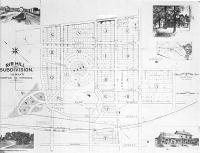|
Barcroft Station, c. 1900, later demolished.
|
|
Until 1920, the residents of suburbs lived near railroad/trolley lines which led to cities. These pioneers of suburbia were fleeing from the problems of the city, such as epidemics. They also got more house for their money. Philadelphia had its Main Line, a string of suburbs built around the turn of the century along the tracks of the Pennsylvania Railroad leading westward from Overbrook to Paoli. Chicago had a similar line. Along Washington's B&O Line, Garrett Park, Kensington and Takoma Park grew up.
A string of much smaller suburbs grew up at the same time along the tracks of the W&OD, from Barcroft to Herndon.
The Washington area was much smaller than Philadelphia until the 1950's. Moreover, Washington's largest suburbs were Takoma and Kensington. The tracks of the W&OD did not lead directly to Washington but rather to Alexandria, where commuters changed trains. The construction of the Bluemont branch solved part of this problem, because it led to Rosslyn, where commmuters could transfer to a trolley to Georgetown.
"Railroad suburbs sprouted along the high iron leading away from most major American cities, and

|
 |
| Never finished, Ayr Hill Subdivision advertised its proximity to the railroad, and especially to the station in Vienna. |
|
commuters firmly believed them to offer the best advantages of rural and urban living. At the heart of their belief lay a continuing respect for agriculture, particuarly for small-scale vegetable gardening...
"Railroad suburbs took two forms, but the 'suburban good life'
guided the development of both.
Speculator suburbs, characterized by quickly erected houses lining new streets across former farmland, blossomed at former village depots within commuting distance of large cities. 'Model' suburbs, usually the result
of enlightened speculators willing to chance long-term profits, were designed and built as whole entities,
the schools, churches, shopping districts and other amenities erected simultaneously with the houses." John Stilgoe, Metropolitan Corridor
Speculator suburbs
New magazines at the turn of the 19th Century
- Countryside Magazine
- Suburban Life
- Country Life
- Hearth and Home
- Garden Magazine
These were some of the popular books at the time
- How and What To Grow in a Kitchen Garden of One Acre
- Out-of-Town Places, 1884 Donald Mitchell
- The Architecture of Country Homes
- The Garden of a Commuter's Wife, 1902 by Mabel Wright
- The Design of Small Properties, 1926
- The Art of Home Landscape, 1932
- Quarter-Acre Possibilities, 1898 Frank Nutter
- A Home Of Your Own And What It Means To You, 1922 M.V. Folsom
|
 |
- Barcroft (Arlington), 1888-1892 grew slowly at first. Owed its existance as much to trolleys as to the railroad. A lively community today.
- East Falls Church (Arlington) built first around the station of East Falls Church and later also on a stop on a trolley line. It had a thriving business district which largely disappeared when Virginia constructed I-66. For decades East Falls Church was incorporated as part of the Town of Falls Church. The residents left the town and returned to the fold of Arlington County to avoid paying taxes.
- Lincoln (Falls Church) originally envisioned as a subdivision for blacks
- Dunn Loring 1887 The Loring Land Improvement Company built four houses before it went bankrupt. See my page on Dunn Loring
- Ayr Hill (Vienna), 1891 conceived by O. E. Hine, a wealthy realtor. Many houses were built. Several survive today.
- Windover Heights (Vienna), 1894 a successful subdivion, today it is the basis of Vienna's historic district, "the Hill."
- Onondio (Vienna), 1915 few houses were built; only the street names, all in Indian tongues, such as Tapawingo and Adahi, survive
- D. Van Vleck's Addition To The Town Of Herndon, 1900 many houses built, several of which survive today. Emphasized proximity to the train station in advertisements.
Model suburbs
- Glen Carlyn (Arlington), founded by a graduate of Oberlin College. A successful "town" then and a vibrant community today, with its own churches, library, school and community center. Gone is its amusement park, but the springs around which it was built still flow.
- Wiehle (Reston) 1887 The location of Wiehle at Thornton's Station on the railroad was not an accident. Dr. Wiehle intended for the railroad to play an integral part in his Utopian community. He planned for industry to line the tracks; in fact a sawmill operated next to the railroad.
Dr. Wiehle built a church which doubled as a townhall and a mansion, both of which still stand today. But all the other houses, which once lined the far shore of the lakes at Old Reston Avenue, are gone. Dr. Wiehle's community never grew fast enough. After he died his heirs had to sell the land.
| "The healthy home became an important consideration by the 1860's. The same concern with sanitation and hygiene that had inspired creation of the wartime Sanitary Commission lead architects, builders and average citizens to associate helath with household designs that provided plenty of sunshine and fresh air. This concern sent Americans scurrying to the countryside. Cities were noisy, crowded, dirty, dangerous, and expensive places to live. Even a modest rowhouse extracted hundreds of dollars a year in rent, and the exorbiant price of urban land made a city house an impossible dream for all but the most affluent people. Why not, asked a growing number of folks, move to the suburbs, where a family of four, even on the outskirts of New York, could buy two acres of land and a commodious house for $6000?" --Daniel Sutherland, The Expansion of Everyday Life, 1860-1876, 1989
|
This page last updated Feb 20, 2006 by webmaster.
This page hosted by 
Get your own Free Home Page
|

